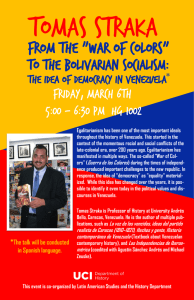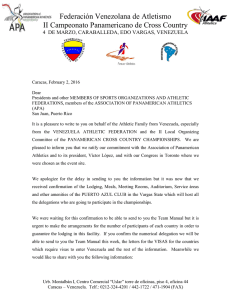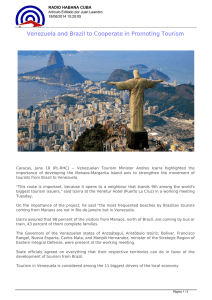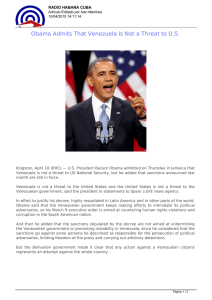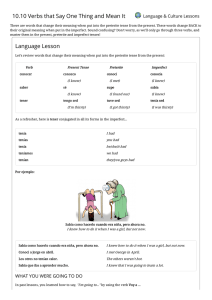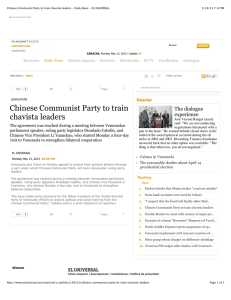Reig (1979) - Barros - Useche - et al - The chromosomes of spiny rats proechimys
Anuncio
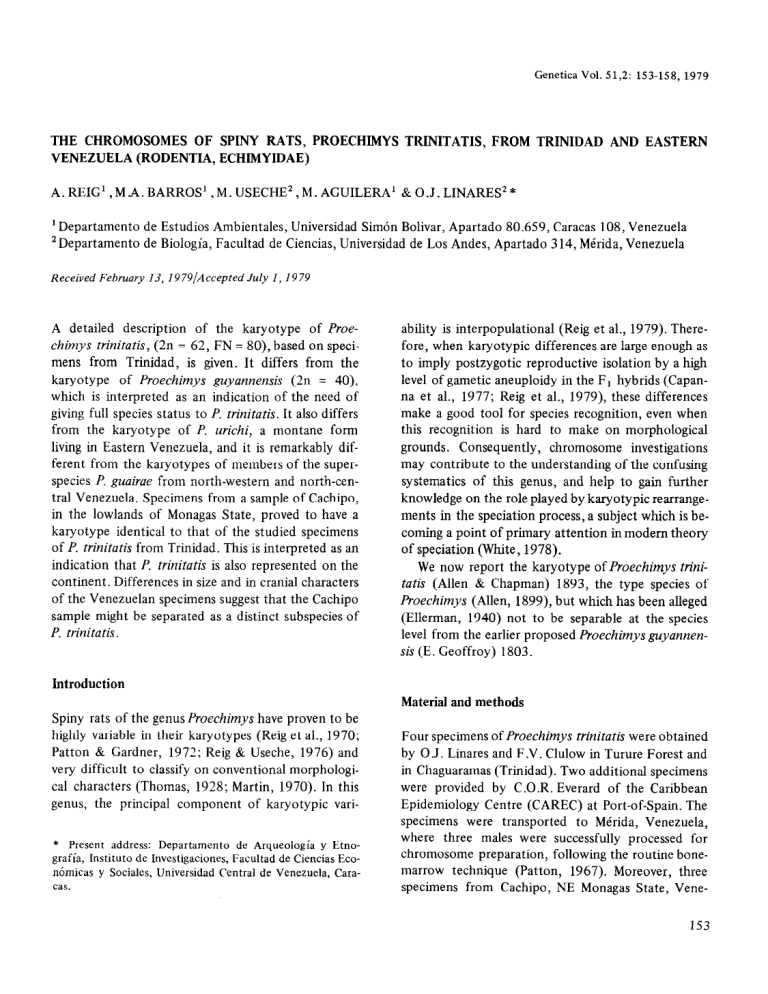
Genetica THE CHROMOSOMES OF SPINY RATS, VENEZUELA (RODENTIA, ECHIMYIDAE) PROECHIMYS A. REIG’ ,M A. BARROS’ , M. USECHE’ , M. AGUILERA’ TRINITATIS, FROM Vol. TRINIDAD 51,2: AND 153-158, 1979 EASTERN & 0 .J. LINARES’ * i Departamento de EstudiosAmbientales,Universidad Simon Bolivar, Apartado 80.659, Caracas108, Venezuela * Departamento de Biologia, Facultad de Ciencias,Universidadde Los Andes, Apartado 3 14, Merida, Venezuela Received February 13,1979fAccepted July I, 1979 A detailed description of the karyotype of Proechimys trinitatis, (2n = 62, FN = SO),basedon specimens from Trinidad, is given. It differs from the karyotype of Proechimys guyannensis (2n = 40) which is interpreted as an indication of the need of giving full speciesstatus to P. trinitatis. It alsodiffers from the karyotype of P. urichi, a montane form living in Eastern Venezuela, and it is remarkably different from the karyotypes of membersof the superspeciesP. guairae from north-western and north-central Venezuela. Specimensfrom a sampleof Cachipo, in the lowlands of MonagasState, proved to have a karyotype identical to that of the studied specimens of P. trinitatis from Trinidad. This is interpreted asan indication that P. trinitatis is also representedon the continent. Differences in size and in cranial characters of the Venezuelan specimenssuggestthat the Cachipo samplemight be separatedas a distinct subspeciesof P. trinitatis. ability is interpopulational (Reig et al., 1979). Therefore, when karyotypic differencesare large enoughas to imply postzygotic reproductive isolation by a high level of gametic aneuploidy in the F, hybrids (Capanna et al., 1977; Reig et al., 1979) these differences make a good tool for speciesrecognition, even when this recognition is hard to make on morphological grounds. Consequently, chromosome investigations may contribute to the understandingof the confusing systematics of this genus, and help to gain further knowledge on the role played by karyotypic rearrangements in the speciationprocess,a subject which is becoming a point of primary attention in modem theory of speciation(White, 1978). We now report the karyotype of Proechimys trinitatis (Allen & Chapman) 1893, the type speciesof Proechimys (Allen, 1899), but which hasbeenalleged (Ellerman, 1940) not to be separableat the species level from the earlier proposedProechimysguyannensis(E. Geoffroy) 1803. Introduction Material Spiny rats of the genusProechimyshave proven to be highly variable in their karyotypes (Reig et al., 1970; Patton & Gardner, 1972; Reig & Useche, 1976) and very difficult to classify on conventional morphological characters(Thomas, 1928; Martin, 1970). In this genus, the principal component of karyotypic vari* Present address: Departamento de Arqueologia y Etnografia, Instituto de Investigaciones, Facultad de Ciencias Econbmicas y Sociales, Universidad Central de Venezuela, Caracas. and methods Four specimens of Proechimys trinitatis were obtained by O.J. Linaresand F.V. Clulow in Turure Forest and in Chaguaramas (Trinidad). Two additional specimens were provided by C.O.R. Everard of the Caribbean Epidemiology Centre (CAREC) at Port-of-Spain. The specimenswere transported to Merida, Venezuela, where three males were successfully processedfor chromosomepreparation, following the routine bonemarrow technique (Patton, 1967). Moreover, three specimensfrom Cachipo, NE Monagas State, Vene- 153 zuela, were provided by Gloria de VillafaAe. Later, four other specimens from the same locality were obtained by O.A. Reig and M. Aguilera. Two females and one male from Cachipo were processed following the same procedure. Voucher specimens of the Trinidadian sample were deposited in the collection of mammals of the University of Los Andes, Merida. Those from Venezuela were incorporated to the collection of mammals of the Simon Bolivar University, Caracas. The Trinidadian specimens were identified as P. trinitatis by the senior author after comparisons with the type and additional specimens at the American Museum of Natural History and the British Museum (Natural History). Karyotypes were constructed from enlarged prints of metaphase photographs. An idiogram was calculated after measuring ten selected metaphases of the Trinidadian specimens. The mean length of each chromosome was expressed as its mean percentage of the total length of the haploid autosomal complement plus one X chromosome (TCL). Nomenclature of chromosomes according to the position of the centromere follows current conventions (Levan et al., 1964). The fundamental number (FN) represents the number of measurable arms of the chromosomes of the autosomal set. The chromosomes were assorted into four groups as in previous publications (Patton & Gardner, 1972; Reig & Useche, 1976). Group A comprises large (> 7% TCL) autosomes, whatever the centromeric index. Group B comprises medium-sized (4-7% TCL) and small (< 4% TCL) metacentric and submetacentric autosomes. Group C comprises medium-sized and 12 Fig. 1. Karyotypes of Proechimys man, 1893). Above: 0, Cachipo, below: d, Turure forest, Trinidad. phases, Giemsa stain. Cf. text. 1.54 trinitatis (Allen & ChapMonagas State, Venezuela; From bone marrow meta- t Fig. 2. Idiogram of froechim.vs trinitatis (Allen & Chapman, 1893). Length expressed as % total length of female haploid complement, indicated in scale at left. Cf. table 1 and text. small telocentric and subtelocentric autosomes. The fourth group includes the gonosomes. Results Seventy-eight metaphases from bone-marrow cells from six specimens were analysed. In all of them 62 chromosomes were counted and the FN was 80. Karyotypes of the three Trinidadian and the three Venezuelan specimens proved to be indistinguishable as regards relative size and centromeric indexes of the different chromosome pairs. Table There is one pair of metacentrics and one pair of submetacentrics in Group A (Figs 1 & 2, Table 1). Group B is made up of six pairs of metacentrics, three of which are medium-sized and are separated by a sharp size gap from the remaining three smaller ones. No secondary constriction is visible in any of these six pairs. Twenty-two autosomes belong to Group C. Pair C-l is a medium-sized T-chromosome bearing a clear achromatic region in the middle. Pair C-2 is a medium-sized subtelocentric. With the exception of pair C-4, which is small and subtelocentric, all remaining Group C autosomes are small telocentrics, gradually decreasing in size. Pair C-6 is distinguished by a 1 Mean values and their standard deviation (SD) of total length, arm lengths and arm ratio (I) of the chromosomes of Proechimys trinitatis. Length expressed as % total length of female haploid complement. Calculated from 10 metaphases of three individuals from Trinidad. Chromosomes C, C4 CS C6 C, C8 C9 C 10 C,, Cl2 C 19 C 14 C IS C 16 C 17 C I8 C 19 C 2” C,, C 21 X Y Total Mean length SD 10.15 7.43 6.82 6.40 5.45 3.18 2.50 1.76 6.02 4.97 3.15 3.27 2.76 2.44 2.31 2.18 2.07 1.95 1.87 1.78 1.73 1.69 1.62 1.57 1.53 1.48 1.45 1.42 1.37 1.27 0.86 0.68 0.29 0.43 0.23 0.54 0.36 0.23 0.51 0.39 0.28 0.36 0.25 0.13 0.11 0.10 0.11 0.09 0.11 0.13 0.12 0.13 0.12 0.12 0.12 0.12 0.13 0.11 0.13 0.15 5.39 5.30 4.03 3.56 3.04 1.80 1.44 0.98 - 0.53 0.69 0.29 0.31 0.22 0.31 0.19 0.13 - 4.20 247 - 5.84 1.80 Long arm Mean SD Short Mean arm Arm ratio SD (r) 4.16 2.13 2.79 2.84 2.41 1.38 1.06 0.78 - 0.31 0.25 0.27 0.19 0.14 0.25 0.21 0.11 - 1.13 2.49 1.44 1.25 1.26 1.30 1.36 1.26 0.35 - 0.77 - 0.09 - 0.78 0.80 - 0.17 - 0.;2 m .$a - 0.37 - 0.90 3.25 0.46 2.56 0.48 1.28 0.30 - - - - - m 1.55 secondary constriction, visible in most of the cells studied, The X-chromosome is a medium-sized (5.85% TCL) metacentric, and the Y is a very small telocentric. Comparisons and discussion The karyotype of Proechimys trinitatis is quite different from that of P. guyannensis, as redefined by Petter (1978) after discovery of the type specimen in Paris. The karyotype of guyannensis is made up of 40 chromosomes, as previously described for P. cherriei (Reig & Useche, 1976), which is considered as a junior synonym of P guyannensis (Petter, op. cit.). The karyotype of guyannensis shows three large submetacentrics and one telocentric in Group A; four medium-sized and small autosomes in Group B, pair B-l bearing a secondary constriction, and ten pairs of medium-sized to small telocentrics in Group C. The X-chromosome is a medium-sized (6.08% TCL) subtelocentric, and the Y is a small telocentric (Reig, Tranier & Barros, 1979). Additionaly, P. guyannensis is clearly different from P. trinitatis in morphology, the former being much smaller and exhibiting distinctive cranial and dental features (Petter, op. cit.). Therefore, there is no room for doubting that trinitatis and guyannensis must be considered as two distinct biological species. Ellerman (1940) was certainly wrong in proposing that trinitatis was merely a subspecies ofguyannensis. The karyotype of P. urichi (Reig & Useche, 1976) which inhabits the mountains of Monagas State, in eastern Venezuela, is very similar to that of P. trinitatis. It consists also of 62 chromosomes, and the X-chromosome is also metacentric, a feature of rare occurrence among species of Proechimys. However, there are important differences between the karyotypes of these two species. In urichi, the autosomes of Group A are significantly smaller, while Group B includes more, and Group C fewer autosomes. Additionally, pair C-l is subtelocentric and does not show an achromatic marker. Karyometric comparisons suggest that at least four pericentric inversions and two translocations account for these differences. Due to the fact that hybrids for several pericentric inversions and translocations usually lead to Fz sterility by zygotic unbalance (Hamerton, 1966; White, 1973) there are good reasons to infer that P. urichi is poten156 tially isolated from P. trinitatis by postzygotic isolating mechanisms, and therefore, to maintain that the two taxa deserve full species status. Another 2n = 62 karyotype has been described for an unnamed new species which inhabits the Barinas and Portuguesa states, Venezuela (Reig & Useche, 1976). In a more recent paper, the species was referred to as Barina’s species (Reig et al., 1979). It also shows a metacentric X and a telocentric C-l autosome with an achromatic region. However, it differs from trinitatis in having significantly larger Group A autosomes, and in showing only three pairs of small metacentrics in Group B, and twenty-five pairs of Group C autosomes. These differences must be the result of at least five deletions/duplications and three pericentric inversions, which also suggest that these two karyomorphs, which are sharply allopatric, might prove to show fertility reduction or complete sterility of possible F, hybrids. Moreover, it is probable that the similarities between the two karyotypes are a matter of convergence, and that the two species are only distantly related. They strikingly differ in cranial morphology (Reig, unpublished observations). Furthermore, Barina’s species belongs to the superspecies P guairae (Reig et al., 1979), in which a transformation series was found in a Rassenkreis of chromosomal forms going from 2n=42 (the allospecies P. POliopus) to 2n=62 (Barina’s allospecies). This superspecies represents a geographically and genetically (Benado et al., 1979) cohesive taxonomic group, which seems to have evolved independently from the set of Proechim-ys populations of eastern Venezuela and Trinidad, to which P. trinitatis belongs. Thus, everything seems to indicate that P. trinitatis is a species well differentiated from P. guyannensis and the allospecies of the P. guairue superspecies, and that it also differs specifically from the more closely related P. urichi. The distinction of P. trinitatis is even far greater when we extend the comparisons to other chromosomally known species of the genus of northern South America and Middle America, like P. brevicauda (2n=24), P. canicollis (2n=24), P. ‘longicaudatus’ (2n=28), P. cuvieri (?n=28), P. amphichoricus (3n=26), P. centralis (= P ‘semispinosus’) (2n=30), P. hendei (2n=32), and the form from Balta, Peru, referred to asP. ‘guyannensis’(2n=40) (Patton & Gardner, 1972; Reig & Useche, 1976; Aguilera et al., 1978; Reig, Tranier & Barros, 1979). The karyotype identity of the specimens from Cachipo, in the lowland forests of NE Monagas, and those of Trinidad poses the problem whether P. trinitatis is alsopresent in the Venezuelan portion of the continent. The overall chromosomal multiformity among species of Proechinzys inclines the present authors to assumethat in spiny rats chromosomal identity indicates absenceof speciesdifferentiation, and therefore, that the Cachipo samplehasto be referred to asP. trinitatis. It cannot be excluded, however, though it doesnot seemto be probable, that the Cachipo sampleis specifically distinct from trinitatis on other grounds. We have found that the specimens from Cachipo are smallerand darker than thosefrom Trinidad, and that they also differ in minor cranial details. The samplesare not large enough,however, to allow a thorough comparative study, but it is probable that the differences found merely representgeographic differentiation within one and the samespecies, which might eventually prove convenient to formalize through subspecies recognition. In any case, the P. trinitatis from Trinidad, the Cachipo population and P. urichi are likely to represent a tightly connected group of forms. This aggregate of closely related speciesand subspeciesmay be conveniently grouped in a superspecies of its own inhabiting Trinidad and eastern Venezuela. This superspeciesshould be named,by priority, Proechimys [trinitatis]. But the situation is further complicated by the fact that easternVenezuela is not only inhabited by the Cachipo trinitatis-like form and the karyotypitally related P. urichi, but also by at least two other chromosomalforms. Some of us are presently studying a population with In=58 chromosomesfrom Rio Casanay, Sucre State, and another one with 2n=52 chromosomeswhich wasfound in Cueva de1Agua, La CaraqueAa,NE Anzoategui State. The relationshipsof those karyomorphs are not yet clearly established, but they seemto indicate an extensive diversification among the spiny rats of NE Venezuela, which may be as intriguing and interesting asthe one found in north western and north central Venezuela (Reig et al., 1979). We are greatly indebted to F.V. Clulow, G. de Villafafie, A. Chang and M.V. de Limongi for field assistance and gifts of specimens.Dr. C.O.R. Everard is heartily acknowledgedfor gifts of specimensand field assistancein Trinidad. We are alsoindebted to M. Benado for critical readingof the manuscript. This work was supported by a grant of the Venezuelan Council of Scientific and Technological Research(CONICIT Sl-0630). References Aguilera, M., O.A. Reig, M.A. Barros & M.G. BasiAez (1978). Caracterizacibn cromosbmica y datos de la biologia reproductiva de Proechimys canicollis de Venezuela. Acta cfent. venez. 29 (Supl. 1): 113. Allen, J.A. (1899). The generic names Echimys and Loncheres. Bull. Am. MUX nat. Hist. 12: 257-264. Allen, J.A. & F.M. Chapman (1893). On a collection of mammals from the Island of Trinidad, with description of new species. Bull. Am. Mus. nat. Hist. 5: 203-234. Benado, M., M. Aguilera, O.A. Reig & F. Ayala (1979). Biochemical genetics of chromosome forms of Venezuelan spiny rats of the Proechimys guairae and Proechimys trinitatis superspecies. Genetica 50: 89-97. Capanna, E., M.V. Civitelli & M. Cristaldi (1977). Chromosomal rearrangement, reproductive isolation and speciation in mammals. The case of Mus musculus. Boll. Zool. 44: 213-246. Ellerman, J.R. (1940). The families and genera of living rodents, Vol. I. British Mus. (Nat. Hist.) London. Hamerton, J.L. (1966). Chromosome segregation in three human interchanges. In: C.D. Darlington and K.R. Lewis, eds., Chromosomes today, 1:237-252. Oliver & Boyd, Edinburgh. Levan, A., K. Fredga & A.A. Sandberg (1964). Nomenclature for centromeric position on chromosomes. Herediras 52: l-22. Martin, R.E. (1970). Cranial and bacular variation in populations of spiny rats of the genus Proechimys (Rodentia, Echimyidae) from South America. Smithson. Con@. Zool. 35: 1-19. Patton, J.L. (1967). Chromosome studies of certain pocket mice, genus Perognathus (Rodentia: Heteromyidae). J. Mammal. 48: 27-31. Patton, J.L. & A.L. Gardner (1972). Notes on the systematics of Proechimys (Rodentia: Echimyidae), with emphasis on Peruvian forms. OCC. Pap. Mus. Zool. La St. Univ. 44: l-30. Petter, F. (1978). Epid6miologie de la leishmaniose en Guyane I’raqaise, en relation avec l’existence d’une espece nouvelle dz rongeurs echimyidds, Proechimys cuvieri, sp. n. C. r. Acad. Sci. Paris 287 (11 Sept. 1978), Skrie D: 261-264. Reig, O.A., M. Aguilera, M.A. Barros & M. Useche (1979). Chromosomal speciation in a Rassenkreis of Venezuelar. spiny rats (genus Proechimys, Rodentia: Echimyidae) In: N.N. Vorontsov, & J.M. van Brink, ed. Animal genetics and evolution. W. Junk, The Hague (in press). Reig, O.A., P. Kiblisky & 1. LGbig (1970). Isomorphic sexchromosomes in two Venczuclan population of spiny-rats, 157 genus Proechimys (Rodentia, Caviomorpha). Experientia 26: 201-202. Reig, O.A., M. Tranier & M.A. Barros (1979). Sur l’identification chromosomique de Proechimys guyannensis (E. Geoffroy) 1803, et de Proechimys cuvieri Petter 1978 (Rodentia. Echimyidae) Mummalia, Paris (in press). Reig, O.A. & M. Useche (1976). Diversidad cariotipica y sistemitica en poblaciones venezolanas de Proechimys (Rodentia, Echimyidae), con datos adicionales sobre poblaciones de Peru y Colombia. Acts cient. venez. 27: 132-140. Thomas, 0. (1928). The Godman-Thomas ex\pedition to Peru. VII, The mammals of the Rio Ucayali. Ann. Msg. nat. Hist. (10) 2: 249-265. White, M.J.D. (1978). Modes of speciution. W.H. Freeman and Co., San Francisco. White, M.J.D. (1973). Chromosomal rearrangements in mammalian populations, polymorphisms and speciation. In: ‘A.B. Chiarelh and E. Capanna, eds, Cytolaxonomy and vertebrate evolution, pp. 95-128. Academic Press, London. 158
